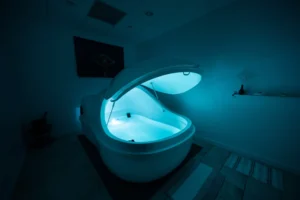In the quest for a night of restful sleep, many find themselves navigating a sea of solutions, from the latest sleep technologies to age-old remedies. Yet, amidst this search, float therapy emerges as a beacon of hope for those plagued by restless nights and elusive dreams. Known also as sensory deprivation therapy, float therapy offers a unique approach to sleep enhancement, relying not on external aids but on the power of silence and stillness. This article delves into the transformative effect of float therapy on sleep quality, exploring the scientific mechanisms at play and how this serene practice can reset sleep patterns, alleviate insomnia, and usher in deeper, more restorative sleep.
At the heart of float therapy is the principle of sensory deprivation. By floating in a tank filled with a saline solution, individuals are shielded from external light and sound, creating an environment that drastically reduces sensory input. This reduction plays a crucial role in the body’s relaxation response, significantly lowering cortisol levels, the stress hormone often implicated in sleep disturbances. The warmth of the water, matched to skin temperature, further enhances this effect, blurring the boundaries between the body and its aqueous environment and promoting a profound state of physical and mental relaxation.

The impact of float therapy on sleep is rooted in its ability to modulate brain wave patterns. Typically, the hustle and bustle of daily life keep our brains in a high-alert beta wave state. However, the sensory-reduced environment of the float tank encourages a transition to alpha and theta waves, brain wave states associated with relaxation, meditation, and the initial stages of sleep. This shift is significant for those suffering from insomnia or disrupted sleep patterns, as it mirrors the natural progression towards sleep, making the transition from wakefulness to sleep more seamless and natural.
Furthermore, float therapy addresses sleep issues from another vital angle: the circadian rhythm. This internal clock regulates the body’s sleep-wake cycle over a 24-hour period. Modern lifestyles, characterized by artificial lighting and screen time, often disrupt this natural rhythm, leading to sleep disorders. By providing a space devoid of external stimuli, float therapy offers a chance to reset this internal clock. The deep relaxation achieved in the tank can help synchronize the body’s sleep-wake cycle with its natural timings, improving sleep onset and quality.
The benefits of float therapy extend into the realm of deep, restorative sleep. The profound relaxation experienced during floating can increase the proportion of time spent in deep sleep stages, characterized by slow-wave brain activity. This stage of sleep is crucial for physical recovery, memory consolidation, and emotional processing, making float therapy not just a pathway to faster sleep onset but to a more qualitative, restorative sleep experience.
Anecdotal evidence and scientific studies alike underscore the potential of float therapy as a silent healer in the realm of sleep health. Individuals who incorporate float sessions into their wellness routines often report not only an easier time falling asleep but also a noticeable improvement in sleep quality. They wake feeling more rested and rejuvenated, with the effects lasting beyond the immediate aftermath of the therapy.
In conclusion, float therapy stands as a testament to the power of sensory deprivation in enhancing sleep quality. Through its ability to reduce stress, modulate brain wave patterns, reset the circadian rhythm, and deepen sleep, float therapy offers a holistic approach to sleep enhancement. It reminds us that in our constant search for external solutions to our sleep woes, the answer may lie in turning inwards, embracing the silence, and letting the tranquil waters of float therapy guide us into the arms of Morpheus.






